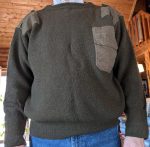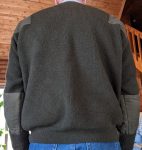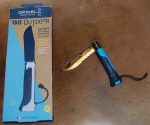This is my gear review of a German Army Wool Commando Sweater Reproduction and Opinel No. 8 Outdoor Sea-Mountain Knife
I love wool sweaters. For roughly nine months out of the year, I wear one pretty much every day. An inventory of my closet reveals a total of 21 wool sweaters: nine “cold-weather-office” sweaters, five “manual-labor” sweaters, and seven “cool-weather-office” sweaters.
Norwegian Sweaters
My love affair with wool sweaters began in Norway, where I lived for ten years. In Norway, wool sweaters are more than just a practical item of clothing. They are an art form.
My first “Norwegian” sweater was technically not a Norwegian Sweater at all. It was a Chinese knock-off of a Norwegian pattern. To be successfully marketed in Norway though, even a Chinese knock-off has to be pretty good. That sweater became my favorite for many years. After I wore holes in the elbows, I took it to a tailor and had leather elbow patches sewed on. When it developed holes elsewhere, it became one of my manual-labor sweaters. I still enjoy wearing it about one-fifth of the time when I am working outside during the winter.
Currently, three of my cold-weather-office sweaters are Norwegian. Two of them I inherited from my parents, who bought them when they visited my family in Norway. One of them my wife found at a thrift store. I am grateful to the tourist who bought a beautiful sweater in Norway and then donated it to a thrift store sometime after returning to the United States.
Military Sweaters
For manual labor during the winter, I love military surplus sweaters. The cut and weave seems to favor physical activity more than most civilian models. My first military surplus sweater formerly saw service in the Royal Dutch Navy. Appropriately, it is navy blue. My second military surplus sweater is an Ango-American, a “Wooly Pully” Sweater made in England and sold through the now defunct Brigade Quartermasters Ltd. in Marietta, Georgia. It is black. Both sweaters were thrift store purchases that have given me many years of excellent service.
The German Army Wool Commando Reproduction
Although I love my Royal Dutch and Wooly Pully sweaters for working, there is at least one drawback to the colors blue and black. They don’t blend into the natural background very well. So I was keeping my eye out for something in an earth tone for hunting and other pursuits that call for lower visibility outside.
 [1]Recently I ran across an ad for Swisslink.com that featured a German Army Wool Commando Sweater Reproduction. It looked like exactly what I had in mind. The only problem was the $59.99 price tag. That was pretty steep for a thrift store shopper like me. It looked so nice that I almost decided to splurge and buy it anyway, but I had not yet made the plunge. Then I visited my favorite thrift store, and was surprised and delighted to find the exact same sweater in like-new condition for just $3.99. The only drawback was that it is one size larger than I normally would have ordered (XXL instead of XL). I bought it anyway, and upon returning home was pleased to find that it was not as large as I would have expected based upon its size. I suspect that is why it ended up in a thrift store in brand new condition. I think some large gentleman with good taste ordered it, and then found out that it was not quite as large as he anticipated. In any case, although it was slightly roomy for me, it was not the tent-like fit that I feared when I bought it. Its appearance gave some hint of someone wearing oversized hand-me-downs from their big brother, but it was very comfortable, and for manual labor I prioritize comfort over appearance.
[1]Recently I ran across an ad for Swisslink.com that featured a German Army Wool Commando Sweater Reproduction. It looked like exactly what I had in mind. The only problem was the $59.99 price tag. That was pretty steep for a thrift store shopper like me. It looked so nice that I almost decided to splurge and buy it anyway, but I had not yet made the plunge. Then I visited my favorite thrift store, and was surprised and delighted to find the exact same sweater in like-new condition for just $3.99. The only drawback was that it is one size larger than I normally would have ordered (XXL instead of XL). I bought it anyway, and upon returning home was pleased to find that it was not as large as I would have expected based upon its size. I suspect that is why it ended up in a thrift store in brand new condition. I think some large gentleman with good taste ordered it, and then found out that it was not quite as large as he anticipated. In any case, although it was slightly roomy for me, it was not the tent-like fit that I feared when I bought it. Its appearance gave some hint of someone wearing oversized hand-me-downs from their big brother, but it was very comfortable, and for manual labor I prioritize comfort over appearance.
Making Room
I have reached the point where I feel that I have an adequate number of items of clothing. So when I buy a new item of clothing, I generally get rid of an old item of clothing to make room for it. In this case, my ragged old college sweatshirt went into the thrift store donation pile so that my new sweater could have its place on the shelf in my closet.
Breaking It In
 [2]Since I purchased this to be a manual-labor sweater, I put it to work already a couple of days after purchase by wearing it for my Saturday chores. In this case, those chores consisted of trash hauling, boiler cleaning, and wood cutting. The day started clear and cold, but started to warm up nicely in the spring sunshine. I quickly shed my jacket, but retained the sweater because it was so comfortable. The wood cutting in particular was quite dirty and strenuous work, and I did snag a few threads on the sweater in the process. I did not mind getting the sweater dirty, because I was eager for an excuse to wash it so that I could see how well it fit afterward.
[2]Since I purchased this to be a manual-labor sweater, I put it to work already a couple of days after purchase by wearing it for my Saturday chores. In this case, those chores consisted of trash hauling, boiler cleaning, and wood cutting. The day started clear and cold, but started to warm up nicely in the spring sunshine. I quickly shed my jacket, but retained the sweater because it was so comfortable. The wood cutting in particular was quite dirty and strenuous work, and I did snag a few threads on the sweater in the process. I did not mind getting the sweater dirty, because I was eager for an excuse to wash it so that I could see how well it fit afterward.
At the end of the day, I threw the sweater in the laundry. A few days later my wife washed it. Since she knew it was a little large, she also put it in the dryer on low heat for 10 minutes. When it came out, it fit perfectly.
Conclusions
Wool sweaters are comfortable, warm, and versatile garments. They are flame and odor-resistant. I highly recommend them for cool and cold weather wear.
It is unusual to find exactly what you are looking for at a thrift store, but it does happen from time to time. It is more common to find something that you would have been looking for if only you had known it was available at such a good price. I highly recommend thrift store shopping to those who have a good thrift store in their area.
Opinel No. 8 Outdoor Sea-Mountain Knife
For many years I kept an original Opinel No. 8 in my mini survival kit. The knife is light, compact, simple, and exceptionally sharp. I like it a lot.
As a survival tool, there are two potential weaknesses with the original design. The beech handle can swell when wet, making the knife difficult to open. And the high carbon steel blade is prone to corrosion. So when I heard about the updated “Outdoor” version of the Opinel No. 8, I was intrigued. The synthetic handle and stainless steel blade of the “Outdoor” version seemed likely to overcome both of the potential weak spots of the original design.
With that in mind, I included the new version of the knife on my Christmas list last year, and was delighted when my daughter and son-in-law gave me one.
Opening the Box
 [3]The box is a nice balance of functional, attractive, and not overly expensive materials. It is made of non-glossy cardstock with a plastic covered knife-shaped window in the top. A cardboard insert holds the knife in place in front of the window. As I removed the knife from the box, I noticed that the handle includes an integrated whistle. I have had whistles integrated into other pieces of equipment in the past, and have not been impressed, so I did not expect much. I was surprised. The whistle is rated to be louder than 110 db, and it certainly is. I was impressed enough that I decided that if this knife became a part of my mini survival kit, it could replace not only my original Opinel No. 8, but also the separate whistle that I keep in the kit.
[3]The box is a nice balance of functional, attractive, and not overly expensive materials. It is made of non-glossy cardstock with a plastic covered knife-shaped window in the top. A cardboard insert holds the knife in place in front of the window. As I removed the knife from the box, I noticed that the handle includes an integrated whistle. I have had whistles integrated into other pieces of equipment in the past, and have not been impressed, so I did not expect much. I was surprised. The whistle is rated to be louder than 110 db, and it certainly is. I was impressed enough that I decided that if this knife became a part of my mini survival kit, it could replace not only my original Opinel No. 8, but also the separate whistle that I keep in the kit.
The blade has a partly serrated edge for rope cutting, which is not my first preference. I prefer a fully non-serrated blade.
 [4]A shackle key is cut into the blade. I did not even know what a shackle key was prior to receiving this knife. This slot cut into the blade allows it to be used as a tool to unscrew a threaded bolt from the head of the type of shackle used to connect marine rigging. Since the “Sea-Mountain” version of the “Outdoor” is designed primarily for boaters and mountaineers, I can understand the inclusion of the tool. Since I was not planning to use the knife in a boating context, I initially would have preferred the stronger blade that would be made possible by eliminating this feature. In use, I found that the shackle key allows for easier one-handed opening than a simple nail nick, so I am now happy with this feature.
[4]A shackle key is cut into the blade. I did not even know what a shackle key was prior to receiving this knife. This slot cut into the blade allows it to be used as a tool to unscrew a threaded bolt from the head of the type of shackle used to connect marine rigging. Since the “Sea-Mountain” version of the “Outdoor” is designed primarily for boaters and mountaineers, I can understand the inclusion of the tool. Since I was not planning to use the knife in a boating context, I initially would have preferred the stronger blade that would be made possible by eliminating this feature. In use, I found that the shackle key allows for easier one-handed opening than a simple nail nick, so I am now happy with this feature.
The box indicates that the knife is rated for temperatures between -40 degrees Fahrenheit and 176 degrees Fahrenheit. I wonder if the synthetic handle becomes brittle in extreme cold, or tacky in extreme heat.
The description on the back of the box is in French, English, German, Spanish, Italian, Dutch,
Japanese, and Russian. It indicates among other things that the blade is made of “high carbon stainless steel”, which was a new concept to me. I thought steel was either high carbon or stainless, and did not know that it could be both.
The blade was plenty sharp enough to shave my left forearm, but I don’t think it is quite as sharp as the carbon steel blade of the original Opinel No. 8.
 [5]I wish that the lanyard hole in the handle was slightly larger to enable it to accommodate a loop of standard paracord. I also would have preferred an earth-tone color for the handle. The handle is in the traditional Opinel shape, and the two synthetic materials of which it is made both feel pleasant in the hand.
[5]I wish that the lanyard hole in the handle was slightly larger to enable it to accommodate a loop of standard paracord. I also would have preferred an earth-tone color for the handle. The handle is in the traditional Opinel shape, and the two synthetic materials of which it is made both feel pleasant in the hand.
Conclusion
I was very pleased with the Opinel No. 8 Outdoor Sea Mountain. I replaced the original Opinel No. 8 and whistle in my mini survival kit with the modernized unit.
Disclaimer
I did not receive any financial or other inducements to mention any vendor, product, or service in this article.